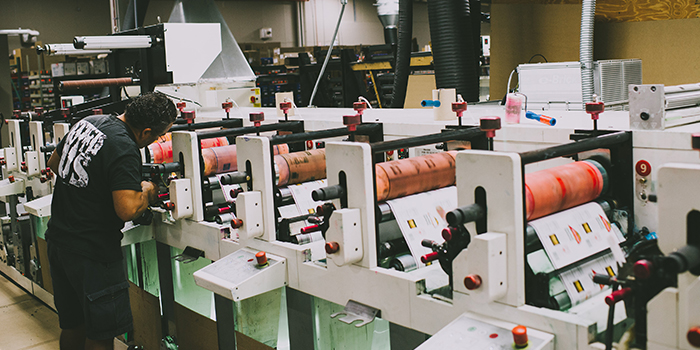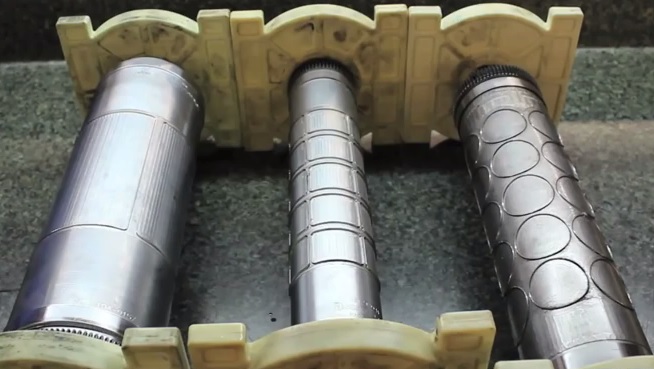Flexographic printing is a popular method for printing large orders of custom labels at rapid speeds – but how does it actually work? And why does it matter? Unlike digital label printing, flexographic printing transfers ink onto the material using flexible printing plates mounted on fast-rotating cylinders. Flexographic printing plates allow customization options that aren’t possible with some other types of presses. Let’s see what flexographic printing can do and why it continues to be one of the best methods for producing custom labels and other print products. So, is flexographic printing the right choice for your labels? You’ll be able to make a more confident decision after reading this article.
How Flexographic Printing Works
Flexographic printing isn’t exactly a “new” technology (we’ve been using flexographic printing presses since we first got into the label industry over 30 years ago!), but it has evolved a great deal over the years and is still one of the most reliable ways to produce great looking labels. A variety of products can be printed on flexographic presses like pressure-sensitive labels, shrink sleeve wraps, pouches, multi-ply labels, double-sided printed labels and more. We understand that the process can be a little intimidating for new label buyers, but don’t worry, it’s pretty straightforward once you understand the basic mechanics. Here are the main things to know about flexographic printing:

Web-Fed Materials
In a nutshell, “web-fed materials” are materials being continuously fed into the flexographic press from large rolls of raw material stock. Using rolls of materials instead of individual sheets allow us to quickly print large orders, cutting to the desired final product at a separate station. With our “flexo” presses, we can print an average of 350 feet per minute – or four miles of material an hour! Flexographic printing is significantly faster than digital, making large runs of labels more cost-effective to print on flexo presses.
Flexible Printing Plates
In this case, printing “plates” are thin sheets of polymer material, laser engraved with an image of your digital artwork. These plates are wrapped around cylinders and installed on the press where they get coated with ink that then transfers onto the web-fed material; each color being printed requires it’s own plate. We have the ability to produce these plates in-house, a capability that not every label printing company has. This allows us to save you time and money with faster lead times and elimination of the cost of a third-party plate maker.
CMYK Printing + Color Options
Full-color labels can be achieved with 4-color process printing which refers to these ink colors: cyan, magenta, yellow and “key” (printing term for black). It’s important to design your label artwork in CMYK colors – not RGB! Screens on computers, smartphones, and tablets use RGB (red, green, blue) colors and can look different from one screen to another due to different displays. Here’s an easy way to remember the difference: CMYK = printing, RGB = electronic screens. We can print single or multi-color labels, resulting in a photographic-quality look. CMYK inks are usually enough to achieve most colors, however, we can also print color variations through Pantone color matching.
Water-Based and Ultraviolet Curable Inks
Water-based and UV curable inks are our go-to systems since they offer great print quality and are less harmful to the environment than solvent inks. Our most popular option is water-based inks as they are less expensive and work on a variety of materials. UV inks are a more specialized type of ink, which are cured by an ultraviolet lamp, turning them from liquid into solid. This process is much faster than air drying. UV inks offer easier press setups and reduce energy consumption since they dry nearly instantaneously. The quick drying time produces sharper colors; the only drawback of UV inks is that it tends to cost more than other ink types.

Cutting Dies
After your label is printed, the next step is to cut them to the desired final shape. “Cutting dies” are metallic cylinders with shallow blades on the surface that slice the label shape into the material so excess material around the labels can be removed. We have thousands of cutting dies in our inventory and offer the option to create a custom cutting die for you (a one-time fee applies). We do everything we can to ensure the right die is paired with your material and liner, while printing companies who aren’t nearly as experienced may select a die that cuts the material/liner too deep, making it hard to remove the label from the liner.
Additional customization options
Our flexo presses are equipped to handle a special process called cold foil stamping which prints foil material onto the web-fed materials, creating metallic accents within the label art. The foil begins as silver, however, we can tint it to gold or any other color you want through Pantone color matching. Another unique flexographic-only option is multi-layer (or “multi-ply”) labels. This specialty label product is great for fitting lots of text onto your packaging without adding much bulk to the product.
Congratulations! You now have a basic understanding of flexographic printing. Wondering how digital printing compares? Check out our printing methods page or video gallery to see them in action.


